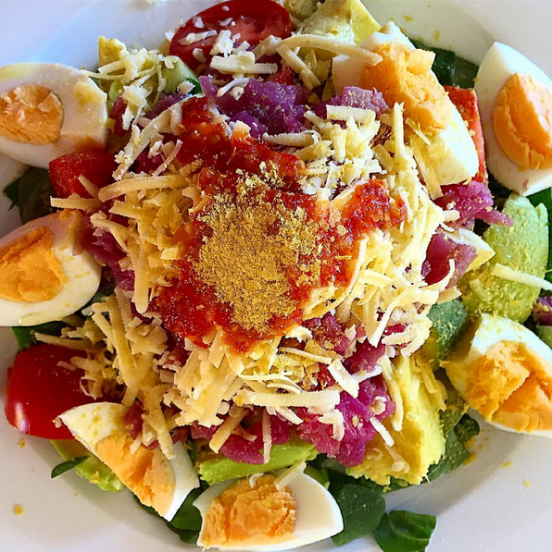I LOVE frittatas. Mostly because I adore eggs (they’re an incredibly nutrient-dense food) but there’s a host of other reasons…
Frittatas are so. damned. easy. to make. You can put an amazing array of stuff in them (which in turn further inflates their nutritional value) and even better, they can be eaten cold as a healthy snack on-the-run. (They even freeze well …. even though I’ve never tried… coz I eat ’em too quickly!) Apart from the baking time, they’re pretty quick to prep.
I needed to harvest my very healthy kale plant a few days ago, and knowing that I could fit a LOT of leafy greens into a frittata, there was no question about what I’d be making. I had a fair bit of broccoli lolling about in the fridge too so grabbed that, but knew I’d need some ‘punchier’ flavour …so I pulled out the sundried tomatoes. And my addiction to turmeric (more specifically its nutritional powers) has reached the point where virtually every egg dish I make features it. This explains the ridiculously intense yellow colouring:
I used the following ingredients:
125gm broccoli florets, 100gm finely chopped kale leaves (if you find kale too strong in flavour you could easily substitute with spinach) 40gm finely chopped sundried tomatoes, 6 eggs, 1 (heaped!) tablespoon of freshly grated turmeric (you could use the powdered stuff, and less of it, if you’re not as fanatical about it as I) salt & black pepper (important inclusion to help your body receive turmeric’s power) 40gm grated cheddar (or parmesan if you prefer) plus extra for topping.
Super simple instructions:
Pre-heat the oven to 180ºC, grease (I use EVOO, that is extra virgin olive oil) and line a shallow baking dish with baking paper, set aside.
First you’ll need to steam your broccoli & kale. The broccoli will take only slightly longer than the kale, so place a steamer in a medium-large saucepan (unless you have another method of doing this – I have a Thermomix – yay for me!) with about one centimetre of water. Whack on the lid and as soon as it comes to the boil, pop in the broccoli. It should only take 3-4 minutes, tops. Haul it out, set it aside, and then throw in all the kale. This should only take about 2 minutes. You just want it to wilt. (Thermies, fill the bowl to the blades, pop the broccoli in the basket and cook 6 minutes Varoma, speed 1-1½. When done, set the broccoli aside, put the kale in the basket and cook for another 2-3 minutes, same temp & speed.)
The broccoli can be laid in the bottom of the baking dish immediately. Then you need to squeeze excess fluid from the kale. You could do this by hand (clean hands of course!) but I use paper towel so that I don’t lose any of the green to my fingers.
Next up, simply beat the eggs with the turmeric, salt and pepper. (Thermies: 5 seconds or so at Speed 5) then pop the kale, sun-dried tomatoes and grated cheese in and mix thoroughly (by hand… you don’t want to pulverise the veggies!)
Now, I opted to spoon the solids (the kale, tomato & cheese) into the baking dish, to fill in the gaps between the broccoli florets … I guarantee if you try to pour the whole mix out you’ll end up with a pile of vege in one spot! Call me OCD, but I’m fairly sure it’ll cook better if the liquids & solids are evenly distributed. I dribbled the remaining egg mix evenly throughout the dish as well.
 The final step is to grate however much extra cheese you want, over the top of the entire dish then whack it in the oven for 30-40 minutes (just check it at the half hour mark: when it appears quite solid in the middle, it should be ready).
The final step is to grate however much extra cheese you want, over the top of the entire dish then whack it in the oven for 30-40 minutes (just check it at the half hour mark: when it appears quite solid in the middle, it should be ready).
Unless your knife is very sharp, I’d let it cool a bit before slicing it into pieces. And I dare you NOT to eat any when you do this… 😉













